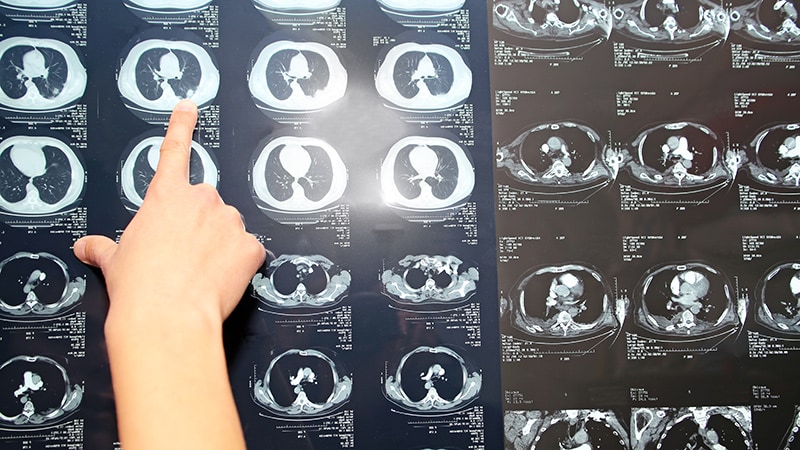Artificial intelligence (AI) can spot incidental pulmonary emboli (iPE) on chest CTs performed for other indications, according to a new study published in the American Journal of Roentgenology.
In a retrospective review of conventional contrast-enhanced chest CTs, the authors found that a commercial AI algorithm had a high negative predictive value for iPE. In addition, the AI picked up on pulmonary emboli that radiologists missed — but the radiologists also picked up on some pulmonary emboli that the AI missed.
“Sometimes these incidental PEs are harder to see on the exams that weren’t optimized for PE,” said Paul H. Yi, MD, assistant professor of diagnostic radiology and nuclear medicine at the University of Maryland School of Medicine and director of the university’s Medical Intelligent Imaging Center, in an interview with Medscape Medical News. Yi was not involved in the study.
“This AI works for this purpose, and this purpose could be really useful, because we don’t always have the benefit of a CTPA [CT pulmonary angiography],” he said.
Echoing one of the authors’ conclusions, Yi added that AI may help radiologists by giving them a “second read or a second opinion, kind of looking over our shoulder.”
Lead author Kiran Batra, MD, told Medscape that in addition to being that second reader, AI could flag certain studies for a priority read, helping radiologists triage ever-increasing workloads.
“I think it’s going to be like a symbiosis and teamwork between the two,” said Batra, who is an assistant professor of radiology, at UT Southwestern Medical Center.
Test-Driving AI
The authors conducted a retrospective study of 3003 consecutive contrast-enhanced chest CTs that did not use pulmonary angiography protocols.
These were performed on 2555 adults between September 2019 and February 2020 at Parkland Health in Dallas, Texas.
The authors examined the results of two algorithms previously applied to the CTs:
-
An FDA-approved commercial AI algorithm (Aidoc) was applied to the images with the aim of detecting iPE. This algorithm was trained on conventional chest CTs. It had been applied prior to the current study, and radiologists caring for the patients did not have access to results.
-
A natural-language processing (NLP) algorithm (RepScheme) was applied to the clinical radiologists’ reads of the scans to see which mentioned iPE.
If either algorithm flagged an iPE, two radiologists independently adjudicated the relevant scans to determine if iPE was present, with a third radiologist available to resolve discrepancies.
In addition, one radiologist examined NLP results and corrected any that misclassified mention of iPE.
A Way to Help Exclude PE
The patients’ mean age was 53.6 years and just over half were women. Over 70% of CTs were done due to cancer.
After adjudication, some 40 iPEs were detected. AI found four iPEs that clinicians had missed, while clinicians spotted seven that AI overlooked.
For AI vs clinical reports, performance was as follows:
-
Sensitivity: 82.5% vs 90.0%, P = .37
-
Specificity: 92.7% vs 99.8%, P = .045
-
Positive predictive value: 86.8% vs 97.3%, P = .03
-
Negative predictive value: 99.8% vs 99.9%, P = .36
“If I’m reading a scan as a radiologist, and I don’t find a PE, I should be looking at the AI to see if it found a PE or not, because it has a high negative predictive value,” Batra said. “If the AI did not find a PE, and I did not find a PE, then the chances of [the patient] not having it are pretty high.”
Limitations included low iPE incidence, which limits study power. Manual review was only applied to scans that were positive by AI or NLP; thus, had iPEs been incorrectly missed by both techniques, the authors would have missed them as well. And the authors pointed out that generalizability is limited, as protocols and patient populations vary.
The Role of AI in Vascular Radiology
PE can present nonspecifically and be notoriously easy to miss. It strikes between 71 to 117 per 100,000 people in the US per year, according to the authors, and it particularly menaces cancer patients, in whom it can herald a worse prognosis.
AI is good at picking up PE on PE-protocol CTs, also called CTPA. Those CTs time the contrast bolus to highlight the pulmonary arteries.
But it had previously been less clear how well the technology would pick up iPE from contrast chest CTs done for other indications, such as cancer or lung disease.
Amid reports of radiologist burnout, a global radiologist shortage, and increased demand for imaging, AI may play an important role. But AI for radiology is still in its infancy, according to Yi.
“It’s got a long way to go,” he said. “I think there’s early wins [in] things like triage and trying to have high negative predictive value. But we’re really a far ways off from replicating what a radiologist does.”
That said, Yi added, there is a lot of nuance in radiology, and there is going to be a need for studies like this one that clinically validate these products.
“This is a third-party, unfunded, unbiased evaluation of [the AI algorithm], and that’s pretty cool,” he said. “It seems to be working as they claim.”
The study was unfunded. Batra and co-authors have disclosed no relevant financial relationships. Yi is a consultant for Bunkerhill Health.
AJR Am J Roentgenol. Published online July 13, 2022. Abstract
Jenny Blair, MD, is a journalist, writer, and editor in Vermont.
For more news, follow Medscape on Facebook, Twitter, Instagram, and YouTube.
Source: Read Full Article






